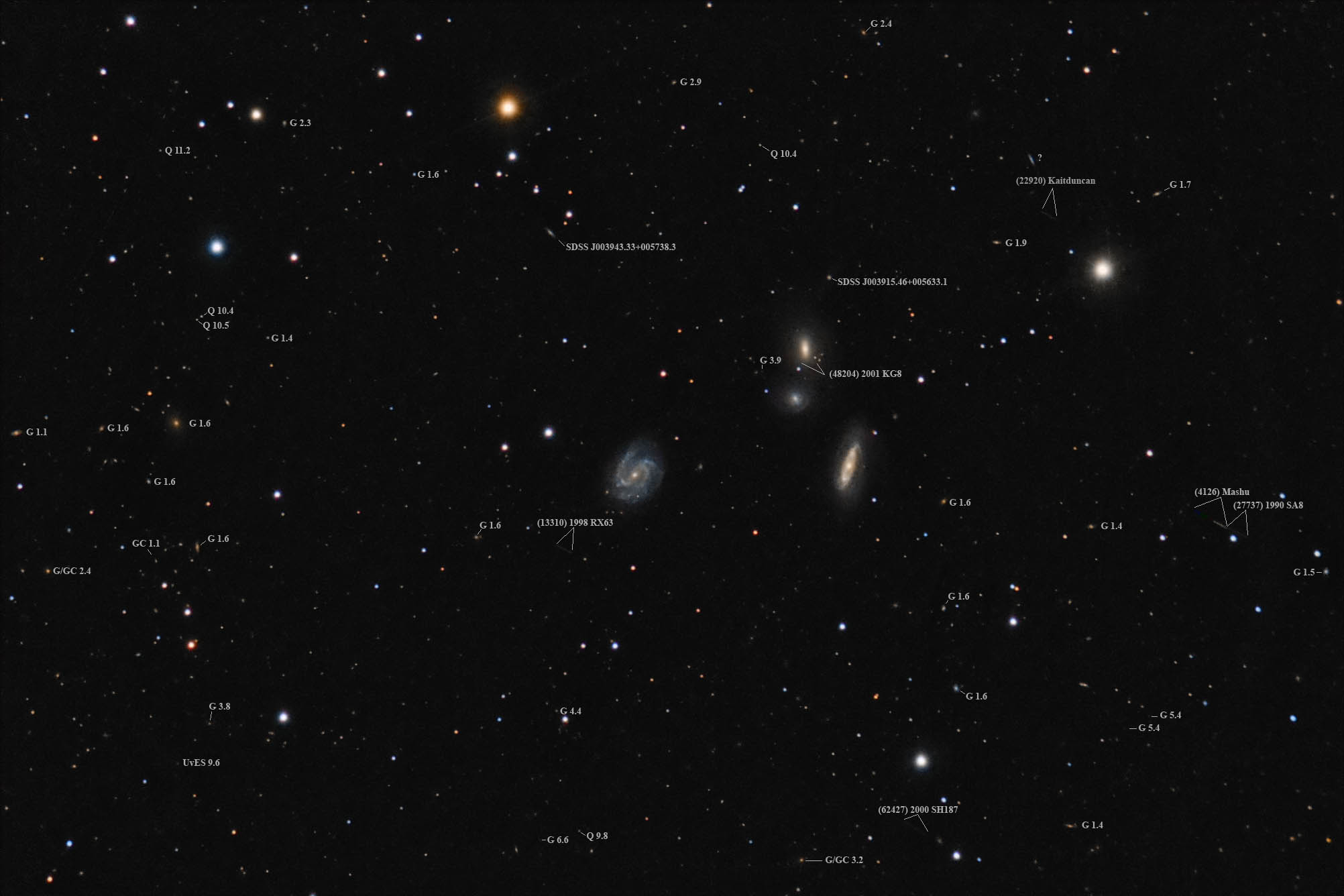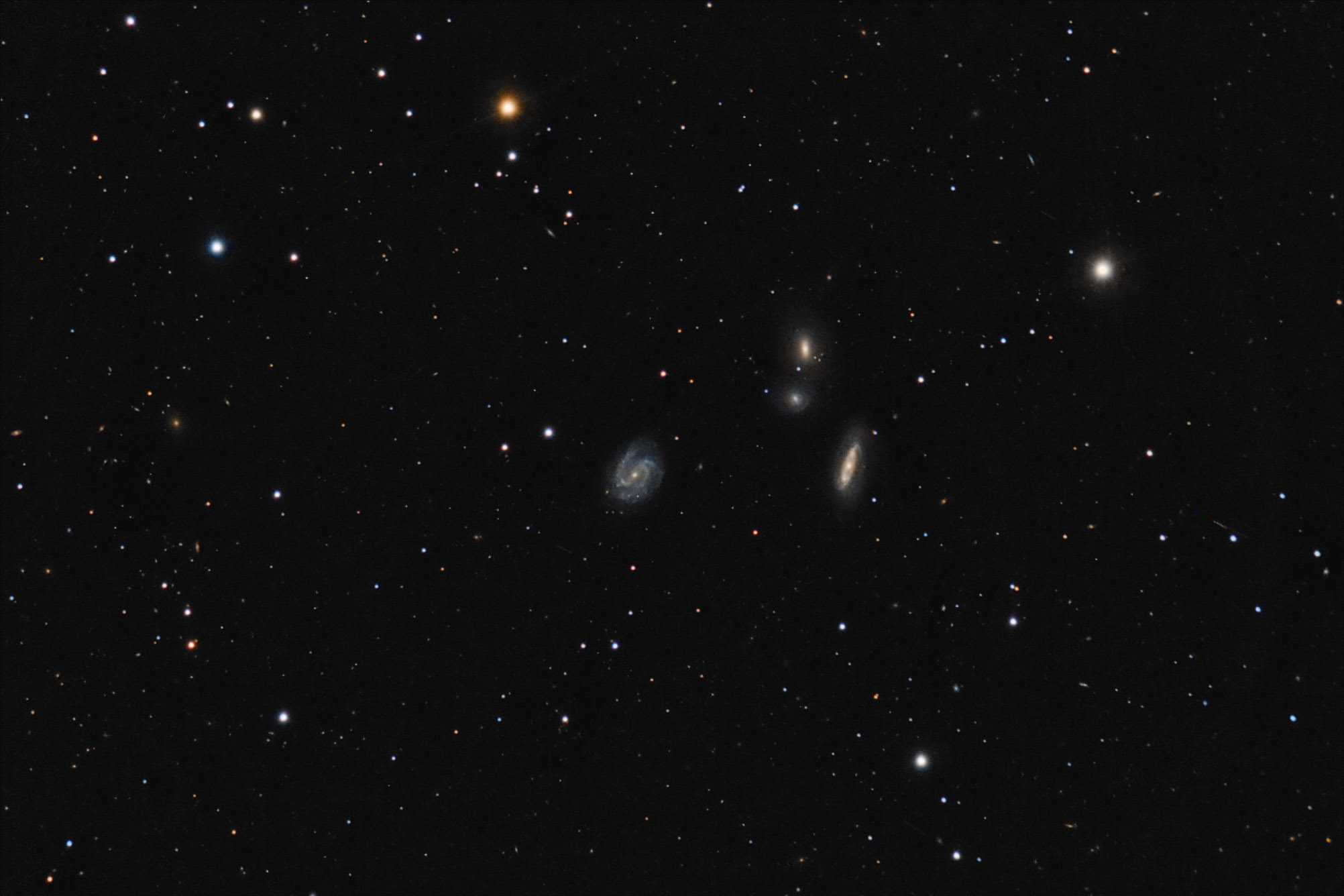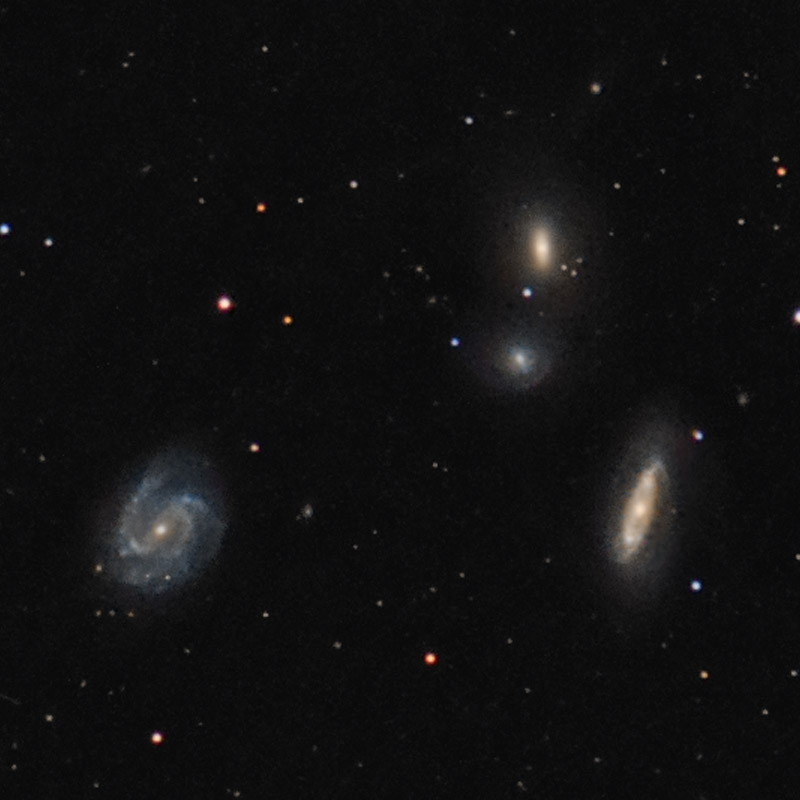Object name: NGC0192Designation(s): NGC0192, NGC0196, NGC0197, NGC0201, HCG07, Hickson 7 consists of the 4 NGC galaxies; NGC 192, 196, 197, 201. They are the 4 largest of a group of galaxies about 180 million light years away in the northwest corner of the constellation of Cetus. Westernmost NGC 192 is classed as (R')SB(r)a?. Its inner arms coming off the bar form a nice ring. Two very thin arms come off this ringlike structure. Is this a result of interaction with one or more others in the group sometime in the past? To the east is NGC 196, it is classed as SB0 pec? Like NGC 192 it is a rather red galaxy with few blue stars except in the outskirts. Below it is NGC 197. It also is classed as SB0^0 pec. But it is very blue and has a couple blue arc on its southwest side. Furthest east is NGC 201 which seems to me a very good candidate for Arp's "split arm" category. After the split the upper arc is very blue compared to the lower one. It is classed as SAB(r)c. Other than the split arm it is the only mostly ordinary galaxy in the group.
NGC 192, NGC 196 and NGC 202 were discovered by William Herschel on December 28, 1790. NGC 197 was discovered by Albert Marth on October 16, 1863.
As usual with well surveyed fields I've provided an annotated image. Galaxies identified by catalog entry that are members of the group and thus about 180 million light years away, are just dwarfs compared the the 4 major galaxies in the image. Those not members of the group are shown by their distance in billions of light years. The group member northwest of NGC 196 appears to have a faint plume through it. Probably comes from IC 196 but possibly those are its stars in the plume.
NED lists over 6 galaxy clusters as being in the image. Most I failed to identify. But notice the red galaxy near the bottom a bit right of center at 3.2 billion light years. It anchors the galaxy cluster SDSS CE J009.833157+00.701518. It can be seen as very faint fuzzies around the far larger core galaxy. Many clusters have a huge elliptical at their core. This one seems far larger in comparison to the other members however. A similar giant elliptical anchoring a cluster is near the left edge below center. Both are marked with a G/GC label. Though I see no obvious members for this second one. The only other galaxy cluster I could find is only 1.1 billion light years distant. It is near the left edge below center and identified with a GC label. In the lower left corner you'll find an object labeled UvES which is an Ultraviolet Excess Source, most likely a quasar considering its distance of 9.6 billion light years. To the NW is a small galaxy above the asteroid (22920) Kaitduncan. While it is reasonably bright it is another not in in the SDSS catalog or any other than the an entry in the Automated Plate Measurement United Kingdom Schmidt catalog of anonymous galaxies. How this happens is still a mystery to me. Usually, as in this case they are rather blue in color. I have no idea if that is coincidence or enters into the omission.
The faintest galaxy in the image that is labeled is the lower of two at 5.6 billion light years toward the lower right corner. It is 22.5. The upper one is listed at 22.2. The galaxy at the bottom just right of center at 6.6 billion light years is brighter, 21.5 but it is quite noticeably elongated spreading that light out making it harder to see. It must be huge to show an angular size at that distance.
There are 6 asteroids in the image. One, while barely visible on the luminance FITS stack was nearly lost when I stretched NGC 196 so it's full extent was visible. Using the clearer FITS data I've marked its location anyway. Of more interest are the two asteroids toward right center. Their trails virtually overlap. I never had that before. The asteroids and their magnitudes are:
(4126) Mashu 17.4
(27737) 1990 SA8 19.0
(13310) 1998 RX63 19.2
(22920) Kaitduncan 19.8
(62427) 2000 SH187 19.9
(48204) 2001 KG8 19.9
Mashu was bright enough its color channels barely show up. I've included them so the trail I show on the annotated image extends beyond the obvious luminance trail though you may need to enlarge the image to see it. Mashu's name is explained: "Named for one of the lakes in Akan National Park, which is located in eastern Hokkaido, a one-hour drive from Kitami and Kushiro. The caldera lake is 20 km in circumference, covers an area of 19.6 square km and has a maximum depth of 212 m. No rivers flow into or out of the lake, which is one of the most transparent in the world, although its surface is almost always shrouded in fog."
The other named asteroid Kaitduncan is named for another high finisher in the Intel science contest. Her asteroid's citation reads: "Kaitlin Duncan (b. 1989) is a finalist in the 2007 Intel Science Talent Search (STS), a science competition for high school seniors, for her behavioral and social sciences project. She attends the Plainedge High School, North Massapequa, New York."
14" LX200R @ f/10, L=4x10' RGB=2x10'x3, STL-11000XM, Paramount ME Related Designation(s):2MASS J00391783+0054458, 2MASS J00391878+0053309, 2MASX J00391339+0051508, 2MASX J00391786+0054458, 2MASX J00391879+0053308, 2MASX J00393485+0051355, 2XMM J003913.3+005150, 2XMM J003917.8+005447, 2XMMp J003913.3+005150, 2XMMp J003917.8+005445, AKARI J0039134+005146, APMUKS(BJ) B003643.92+003818.0, APMUKS(BJ) B003644.89+003702.8, APMUKS(BJ) B003700.98+003508.4, ASK 029773.0, ASK 029793.0, CALIFA 026, CGCG 0036.7+0035, CGCG 0036.8+0038 NED01, CGCG 0036.8+0038 NED02, CGCG 0037.1+0035, CGCG 383-051, CGCG 383-053 NED01, CGCG 383-053 NED02, CGCG 383-059, CXO J003913.4+005151, CXO J003917.8+005444, CXO J003934.8+005135, GALEXASC J003917.69+005445.9 , GALEXASC J003918.84+005332.7 , GALEXASC J003934.86+005135.4 , GALEXMSC J003917.68+005443.2 , GALEXMSC J003918.89+005332.3 , GALEXMSC J003934.90+005135.1 , HCG 007, HCG 007A, HCG 007B, HCG 007C, HCG 007D, HCG07, HDCE 0027, HDCE 0027 NED001, HDCE 0027 NED002, HDCE 0027 NED003, IRAS 00366+0035, IRAS 00370+0035, IRAS F00366+0035, IRAS F00370+0035, LDCE 0034 NED004, LDCE 0034 NED005, LDCE 0034 NED008, LGG 010:[G93] 002, LGG 010:[G93] 003, LGG 010:[G93] 004, LGG 010:[G93] 006, MCG +00-02-104, MCG +00-02-107, MCG +00-02-110, MCG +00-02-115, NGC 0192, NGC 0196, NGC 0197, NGC 0201, NGC0192, NGC0196, NGC0197, NGC0201, NPM1G +00.0016, NSA 005901, NSA 005902, NSA 062093, NSA 153593, NVSS J003913+005149, NVSS J003934+005127, PCC S49-122, PGC 002352, PGC 002357, PGC 002365, PGC 002388, PPS2 075, RESOLVE rf0037, RESOLVE rf0540, RESOLVE rf0542, RSCG 03, SDSS J003913.40+005150.7, SDSS J003913.41+005150.9, SDSS J003913.75+005142.5, SDSS J003917.83+005445.9, SDSS J003918.79+005330.9, SDSS J003918.79+005331.0, SDSS J003918.79+005331.1, SDSS J003934.82+005135.6, SDSS J003934.82+005135.8, SDSS J003934.83+005135.8, SDSS J003934.83+005135.9, SSTSL2 J003913.38+005150.8, SSTSL2 J003917.83+005445.9, SSTSL2 J003918.77+005330.0, SSTSL2 J003918.79+005331.4, SSTSL2 J003934.85+005135.5, UGC 00401, UGC 00405, UGC 00406, UGC 00419, USGC U024 NED01, USGC U024 NED02, USGC U024 NED03, UZC J003913.5+005149, UZC J003917.8+005445, UZC J003934.9+005135, UZC-BGP 05A, UZC-BGP 05B, UZC-CG 009 NED01, UZC-CG 009 NED02, UZC-CG 009 NED03, v2MCG 04, v2MCG 04:[DMP2012] 1, v2MCG 04:[DMP2012] 2, v2MCG 04:[DMP2012] 3, v2MCG 04:[DMP2012] 4, WBL 015, WBL 015-001, WBL 015-002, WBL 015-003, [WGB2006] 003642+00350_a, [WGB2006] 003642+00350_b, [WGB2006] 003642+00350_c, | | 

